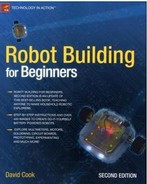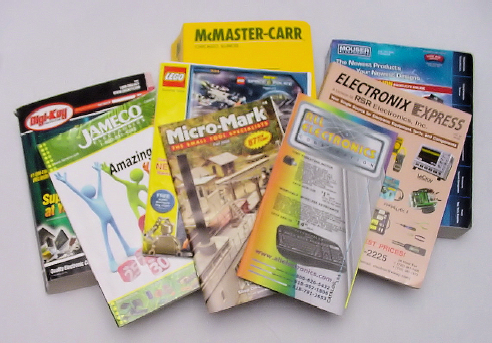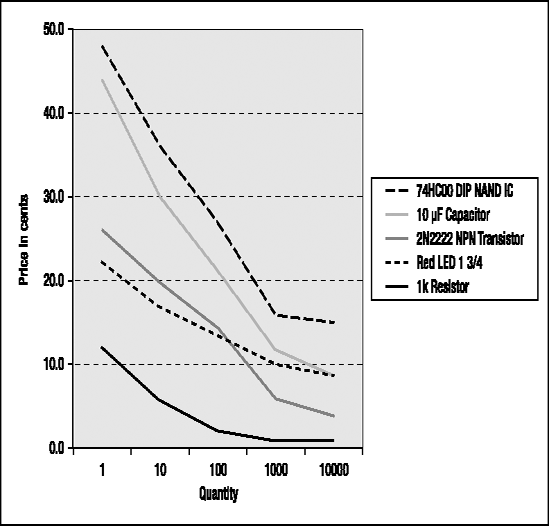Lots of different parts and lots of different tools are needed to build high-quality robots.
If something is frustrating or difficult to make, or is otherwise turning out badly, then either you are using the wrong tool or you are using it incorrectly. In fact, some jobs are literally impossible without the right instrument. Using the correct tools in the correct manner makes almost any job fast and easy.
The same principle applies to parts. There are an infinite number of materials that you can employ to build a robot or provide a particular feature. It's important to choose materials that will make your robot more robust, adaptable, and less expensive.
Often, the greatest barrier is not knowing that a tool or part exists.
A good place to start is to order some free catalogs. Take a few minutes, now, to order complimentary printed catalogs (see Figure 2-1) from most of the retail companies listed in Table 2-1. It's going to take a few weeks to receive the publications, so you might as well have the companies start the process while you enjoy reading the rest of this book.
Although online sites are useful for ordering and for more detailed information, the printed catalogs are better for browsing and lazy reading. They also make for pleasant surprises when they arrive in the mailbox.
Table 2.1. Retail Companies, Most with Printed Catalogs
COMPANY | CATEGORY | WEBSITE |
|---|---|---|
Digi-Key | electronics |
|
All Electronics | electronics, surplus |
|
B. G. Micro | electronics, surplus |
|
Jameco Electronics | electronics |
|
Electronix Express | electronics |
|
Electronic Goldmine | electronics |
|
Mouser Electronics | electronics |
|
Marlin P. Jones | electronics, surplus |
|
Micro-Mark | tools, materials |
|
McMaster-Carr | tools, materials |
|
MSC Industrial Supply | tools, materials |
|
Small Parts | tools, materials |
|
Micro Fasteners | fasteners (screws) |
|
Solarbotics | kits, parts |
|
SparkFun | kits, parts |
|
Tower Hobbies | R/C, batteries, motors |
|
LEGO Shop At Home | kits, parts | shop.lego.com |
With the exception of LEGO, the companies in Table 2-1 carry products from many different manufacturers. Most manufacturers themselves also have catalogs. As you begin to discover a personal preference for a particular manufacturer's parts, check the manufacturer's web site to see if they have any free printed material or even free sample parts.
Discovering Hidden Messages
Besides their obvious content, catalogs also provide an unintentional education. Since every square inch of printed page costs money, the companies try to condense data as much as possible. Sometimes what's not there is as important as what is there.
If you want to know the most significant differences in a family of parts, just check out the table columns the catalog companies publish to compare them.
Hmm, if color, wavelength, dimensions, and brightness are all listed for LEDs, then those must be some of the most distinguishing characteristics between types of LEDs. Weight isn't listed, because that isn't a common concern for LEDs.
Another subtle message contained in a parts catalog is the number of pages devoted to a family of parts. If surface-mount capacitors take up a lot of space in a particular catalog, you can infer that enough people are buying enough of those parts to be worth listing them.
The amount of space given to a variation of parts can also be noteworthy. If there are twenty lines of text dedicated to one variation of a part, but only one line of text for another part, perhaps the one-line variation has an unnoticed limitation.
On a sad note, if your favorite parts or packages seem to be receiving less and less coverage from subsequent catalogs, perhaps something is changing in the industry. It might be worth investigating whether that particular piece of technology is fading away.
The price list also tells a story. The chips listed in Table 2-2 all provide the identical logic function. So why the huge range in price?
Table 2.2. Single-Unit Prices for the Same Chip Function
Chip | Price |
|---|---|
7400 | 109 cents |
74LS00 | 56 cents |
74HC00 | 45 cents |
74AC00 | 50 cents |
74AUC00 | 88 cents |
Researching the plain 7400 chip reveals that it uses the most power, provides poor high-output current, and has no feature better than the other chips. Why is it the most expensive? Because it's obsolete. It's a really old design. If you're among the few people who still want that part, the lack of sales volume is going to cost you.
The lowest price on this list happens to be for a technology, 74HC00, that is very popular and has fully matured. Rounding out the bell curve is the newest technology, 74AUC00, which isn't selling yet at a high enough volume to bring down the price.
Of course, there are exceptions. With labor-intensive or rare-material parts, higher prices may be an indication of better quality parts rather than obsolescence or the latest technology.
You can spend money more efficiently by:
purchasing in larger quantities
ordering from catalogs rather than retail
looking for discounts for purchasing online
avoiding handling fees for minimum order amounts by bundling smaller orders
considering the shipping costs
When purchasing inexpensive components, think about purchasing in quantities larger than you need for a single project. In quantities of 100, many components are half the price of a single piece (see Figure 2-2). Some components cost so little (such as resistors) that they often aren't available in quantities fewer than 10.
Consider informally organizing a group to buy a larger quantity of a particular item. Not only will each individual lower the unit cost of their parts, but also the group splits the shipping costs.
I try to support my local electronic, hardware, and hobby stores so that they will be there when I need them. There are some items, such tools and body materials, that are better to examine in person. However, for electronic parts, the costs are often exorbitant and the selection is limited in retail locations.
Most catalog companies offer better prices than retail stores because the stock is consolidated and is warehoused at a few low-rent locations. Since customers aren't walking through the aisles, the products can be stored more densely and needn't be packaged attractively.
Online companies can further reduce costs over catalog companies by decreasing the size of printed catalogs or eliminating them altogether. In addition, online order systems don't have the labor and toll costs of phone orders. Thus, even many catalog companies offer additional discounts for orders placed online.
Watch out for minimum order amounts. Most online and catalog companies charge a handling fee below a certain total order size. The minimum order size is often $20 to $25. Also, consider the cost of shipping. It tends to have a significant base price that grows relatively slowly with weight.
In summary, by consolidating smaller orders into a single purchase and by buying in larger quantities, the per-unit price of components can be dramatically reduced. Simply plan ahead or combine orders with friends or local club members.


